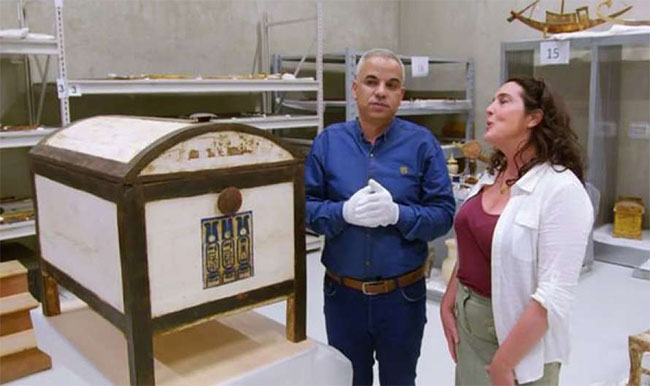First time opening a mysterious box in the tomb of the youngest king in Egypt
Archaeologists recently decided to open a mysterious box found inside the tomb of Egyptian Pharaoh Tutankhamun.
According to Express, the Valley of Kings on the west bank of the Nile is one of Egypt's most famous archaeological sites. There are a total of 63 tombs, containing mummies of Pharaohs like Ramses II, Ramses III and Seti.
The youngest and most famous Egyptian king in this area is Pharaoh Tutankhamun . The tomb was excavated in 1922, led by English archaeologist Howard Carter.
The tomb contains a wealth of possessions, including a mysterious box on display at the Cairo museum. English historian Bethany Hughes was fortunate to have the opportunity to witness firsthand the archaeologists opening a secret box.
Hughes said: 'One of the most remarkable artifacts is this box. It appears in Carter's photographs.

The mysterious box was found in the tomb of Egyptian Pharaoh Tutankhamun.
After analysis, we found that this box was not of Pharaoh Tutankhamun but of the king's wife. This is also the first time archaeologists have opened the box on camera lenses.
Unfortunately, what is inside is not the same as the archaeological expectations. Hughes said: 'The box is empty, unfortunately. But we can smell the specific smell. The smell of wood and plastic, is like that of history. '
Hughes added that archaeologists are still unclear why the box was placed in the Pharaoh Tutankhamun's tomb.
In front of the camera lens, Hughes told viewers other findings in the archaeological site called KV62.'The most valuable thing in Pharaoh Tutankhamun's tomb was found in 1925, three years after excavation of the tomb ,' Hughes said. 'It was the mask of the Egyptian king, placed right in the coffin with the mummy Pharaoh Tutankhamun.'
This mask is now on display at a museum in Cairo, Egypt. The tomb of Pharaoh Tutankhamun contains many unresolved mysteries, including Carter's expedition team mysteriously passing away.
Someone once said that the curse of Pharaoh does not distinguish whether it is grave robbers, or archaeologists. By 1929, seven years after the tomb excavation, a total of 22 people involved in the project died. Carter died in 1949, due to natural causes.
- Egypt examined Tut's tomb to find Queen Nefertiti
- The skeptical expert went to the secret room hidden in King Tut's tomb
- The hidden room in King Tut's tomb is full of treasures
- Egypt made a false tomb for King Tut
- A series of Egyptian kings died of epilepsy?
- Discover the mysterious 'watchman' tomb in Egypt
- The spell of the spell on the Pyramid tombstone
- The mausoleum of the beautiful Queen of Egypt despite the destruction of her stepmother
- Egypt will receive 19 items in Tutankhamun's grave
- Discovered the phenomenon of King Tut's grandfather
- Discovered the original Korean king's tomb after 1,000 years
- Mysterious deaths when touching
 Discovered an ancient centipede fossil 99 million years old
Discovered an ancient centipede fossil 99 million years old Discovered bat-like dinosaurs in China
Discovered bat-like dinosaurs in China Discovered a 200-year-old bronze cannon of the coast
Discovered a 200-year-old bronze cannon of the coast Discover 305 million-year-old spider fossils
Discover 305 million-year-old spider fossils